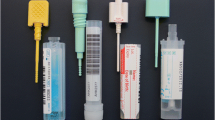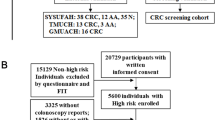Abstract
Background
The advantage of the quantitative fecal immunochemical test (FIT) is the flexibility to set the positivity threshold. However, the diagnostic success of the FIT has not been compared for standard and low cut-off thresholds.
Aims
The purpose of this study was to compare the diagnostic success of FIT for standard and low cut-off thresholds.
Methods
In 2009 and 2010 a standard cut-off threshold (20 μg Hb/g feces) was used as positivity criterion for the FIT; in 2012 a low cut-off (10 μg Hb/g feces) was used. Diagnostic success was compared between the two groups.
Results
Of the total of 14,289 participants, 195 (1.4 %) had positive FIT results. Positivity of the FIT was significantly higher in the low cut-off group than in the standard cut-off group (1.8 vs. 1.0 %, p = 0.000). Although detection of advanced neoplasia lesions was comparable, proximal neoplasia was more frequently detected in the low cut-off group (33.3 vs. 20.9 %, p = 0.016). With the low cut-off threshold, 39 (0.7 %) participants were also classified as having positive results, and 18 (46.2 %) of these had colorectal neoplasias. The number of positive results from the FIT was increased by 54.9 %, and detection of advanced neoplasia was increased by 60 % with the low cut-off threshold compared with the standard cut-off.
Conclusions
A low cut-off threshold for the FIT resulted in better detection of proximal neoplasia in population-based screening. These results indicate the cut-off threshold for positive FIT should be properly chosen and adjusted in colorectal cancer screening.

Similar content being viewed by others
References
Choi KS, Jun JK, Lee HY, Hahm MI, Oh JH, Park EC. Increasing uptake of colorectal cancer screening in Korea: a population-based study. BMC Public Health.. 2010;10:265.
Shim JI, Kim Y, Han MA, et al. Results of colorectal cancer screening of the national cancer screening program in Korea, 2008. Cancer Res Treat.. 2010;42:191–198.
Winawer SJ, Flehinger BJ, Schottenfeld D, Miller DG. Screening of colorectal cancer with fecal occult blood testing and sigmoidoscopy. J Natl Cancer Inst. 1993;85:1311–1318.
Mandel JS, Church TR, Bond JH, et al. The effect of fecal occult-blood screening on the incidence of colorectal cancer. N Engl J Med. 2000;343:1603–1607.
Atkin WS, Cuzick J, Northover JM, Whynes DK. Prevention of colorectal cancer by once-only sigmoidoscopy. Lancet. 1993;341:736–740.
Mandel JS, Bond JH, Church TR, et al. Reducing mortality from colorectal cancer by screening for faecal occult blood. N Engl J Med. 1993;328:1365e71.
Hardcastle JD, Chamberlain JO, Robinson MH, et al. Randomised controlled trial of faecal occult-blood screening for colorectal cancer. Lancet. 1996;348:1472–1477.
Kronborg O, Fenger C, Olsen J, Jørgensen OD, Søndergaard O. Randomised study of screening for colorectal cancer with faecal-occult-blood test. Lancet. 1996;348:1467–1471.
Jørgensen OD, Kronborg O, Fenger C. A randomized study of screening for colorectal cancer using faecal occult blood testing: results after 13 years and seven biennial screening rounds. Gut. 2002;50:29–32.
Young GP, St John DJ, Winawer SJ, Rozen P; WHO (World Health Organization) and OMED (World Organization for Digestive Endoscopy). Choice of fecal occult blood test for screening: recommendations based on performance characteristics in population studies: a WHO (World Health Organization) and OMED (World Organization for Digestive Endoscopy) report. Am J Gastroenterol. 2002;97:2499–2507.
Grazzini G, Visioli CB, Zorzi M, et al. Immunochemical faecal occult blood test: number of samples and positivity cutoff. What is the best strategy for colorectal cancer screening? Br J Cancer. 2009;100:259–265.
Leiberman DA, Holub J, Eisen G, Kraemer D, Morris CD. Utilization of colonoscopy in the United States: results from a national consortium. Gastrointest Endosc. 2005;62:875–883.
Guittet L, Bouvier V, Mariotte N, et al. Comparison of a guaiac based and an immunochemical faecal occult blood test in screening for colorectal cancer in a general average risk population. Gut. 2007;56:210–214.
Fenocchi E, Martinez L, Tolve J, et al. Screening for colorectal cancer in Uruguay with an immunochemical faecal occult blood test. Eur J Cancer Prev. 2006;15:384–390.
Rubeca T, Rapi S, Confortini M, et al. Evaluation of diagnostic accuracy of screening by fecal occult blood testing (FOBT). Comparison of FOB Gold and OC Sensor assays in a consecutive prospective screening series. Int J Biol Markers.. 2006;21:157–161.
Grazzini G, Gastiglione G, Ciabattoni C, et al. Colorectal cancer screening programme by faecal occult blood test in Tuscany: first round results. Eur J Cancer Prev. 2004;13:19–26.
Sohn DK, Jeong SY, Choi HS, et al. Single immunochemical fecal occult blood test for detection of colorectal neoplasia. Cancer Res Treat.. 2005;37:20–23.
Castiglione G, Grazzini G, Miccinesi G, et al. Basic variables at different positivity thresholds of an quantitative immunochemical test for faecal occult blood. J Med Screen. 2002;9:99–103.
Park DI, Ryu S, Kim YH, et al. Comparison of guaiac-based and quantitative immunochemical fecal occult blood testing in a population at average-risk undergoing colorectal cancer screening. Am J Gastroenterol. 2010;105:2017–2025.
Omata F, Shintani A, Isozaki M, et al. Diagnostic performance of quantitative fecal immunochemical test and multivariate prediction model for colorectal neoplasms in asymptomatic individuals. Eur J Gastroenterol Hepatol. 2011;23:1036–1041.
Rozen P, Levi Z, Hazazi R, et al. Quantitative colonoscopic evaluation of relative efficiencies of an immunochemical faecal occult blood test and a sensitive guaiac test for detecting significant colorectal neoplasms. Aliment Pharmacol Ther. 2009;29:450–457.
Yoo KY. Cancer control activities in the republic of Korea. Jpn J Clin Oncol.. 2008;38:327–333.
Cha JM, Lee JI, Joo KR, Shin HP, Park JJ. Telephone reminder call in addition to mailing notification improved the acceptance rate of colonoscopy in patients with a positive fecal immunochemical test. Dig Dis Sci. 2011;56:3137–3142.
Fraser CG, Allison JE, Halloran SP, Young GP. Expert working group on fecal immunochemical tests for hemoglobin, colorectal cancer screening committee, world endoscopy organization. A proposal to standardize reporting units for fecal immunochemical tests for hemoglobin. J Natl Cancer Inst. 2012;104:810–814.
Terhaarsive Droste JS, Oort FA, van der Hulst RW, et al. Higher fecal immunochemical test cutoff levels: lower positivity rates but still acceptable detection rates for early-stage colorectal cancers. Cancer Epidemiol Biomarkers Prev. 2011;20:272–280.
Haug U, Hundt S, Brenner H. Quantitative immunochemical fecal occult blood testing for colorectal adenoma detection: evaluation in the target population of screening and comparison with qualitative tests. Am J Gastroenterol. 2010;105:682–690.
Levi Z, Rozen P, Hazazi R, et al. A quantitative immunochemical fecal occult blood test for colorectal neoplasia. Ann Intern Med. 2007;146:244–255.
Wilschut JA, Hol L, Dekker E, et al. Cost-effectiveness analysis of a quantitative immunochemical test for colorectal cancer screening. Gastroenterology. 2011;141:1648–1655.
Sobhani I, Alzahouri K, Ghout I, Charles DJ, Durand-Zaleski I. Cost-effectiveness of mass screening for colorectal cancer: choice of fecal occult blood test and screening strategy. Dis Colon Rectum. 2011;54:876–886.
Morikawa T, Kato J, Yamaji Y, et al. A comparison of the immunochemical fecal occult blood test and total colonoscopy in the asymptomatic population. Gastroenterology. 2005;129:422–428.
Haug U, Kuntz KM, Knudsen AB, et al. Sensitivity of immunochemical faecal occult blood testing for detecting left- vs. right-sided colorectal neoplasia. Br J Cancer. 2011;104:1779–1785.
Baxter NN, Goldwasser MA, Paszat LF, et al. Association of colonoscopy and death from colorectal cancer: a population-based, case-control study. Ann Intern Med. 2009;150:1–8.
Brenner H, Chang-Claude J, Seiler CM, Rickert A, Hoffmeister M. Protection from colorectal cancer after colonoscopy: a population-based, case-control study. Ann Intern Med. 2011;154:22–30.
Van Rossum LG, Van Rijn AF, Laheij RJ, et al. Random comparison of guaiac and fecal immunochemical blood tests for colorectal cancer in a screening population. Gastroenterology. 2008;135:82–90.
Van Roon AH, Wilschut JA, Hol L, et al. Diagnostic yield improves with collection of 2 samples in fecal immunochemical test screening without affecting attendance. Clin Gastroenterol Hepatol.. 2011;9:333–339.
Cha JM, Lee JI, Joo KR, et al. Performance of the fecal immunochemical test is not decreased by high ambient temperature in the rapid return system. Dig Dis Sci. 2012;57:2178–2183.
Cha JM, Lee JI, Joo KR, Shin HP, Park JJ. Telephone reminder call in addition to mailing notification improved the acceptance rate of colonoscopy in patient with a positive fecal immunochemical test. Dig Dis Sci. 2011;56:3137–3142.
Conflict of interest
None.
Author information
Authors and Affiliations
Corresponding author
Rights and permissions
About this article
Cite this article
Cha, J.M., Lee, J.I., Joo, K.R. et al. Use of a Low Cut-Off Value for the Fecal Immunochemical Test Enables Better Detection of Proximal Neoplasia. Dig Dis Sci 58, 3256–3262 (2013). https://doi.org/10.1007/s10620-013-2819-2
Received:
Accepted:
Published:
Issue Date:
DOI: https://doi.org/10.1007/s10620-013-2819-2




